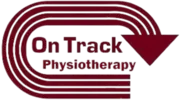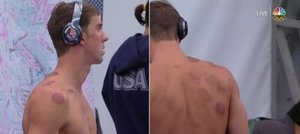Ann Arbor, Mi – Cupping Therapy has been around for a long time. However, this year’s Olympics has brought this type of soft tissue therapy to the forefront in the public.
It’s only natural that when the most decorated Olympian of all time Michael Phelps has odd bruising circles on his shoulder, people start to wonder. Suddenly Cupping therapy became a hot topic of discussion.
On Track Physical Therapy in Ann Arbor, Mi utilizes cupping therapy as an adjunct to clients treatment programs.
Before we go any further, understand that these athletes are on such a high level that they are looking for any advantage they can have over their opponents. Most of these athletes have access to a medical provider daily. They are often pushing their body to the max and training daily, so anything that can potentially aid in recovery is paramount.
To say what the general public or recreational athlete needs is the same as what an elite athlete would need, simply is not true. Most of the general public waits until they are injured before actually seeing a health professional. Furthermore, the general public doesn’t come close to seeing a health professional daily. More likely 1-3x per week when injured, or a couple times per year as a “tune up” if lucky. We will get into the potential advantages cupping may bring to the table in a moment. But the most important thing to remember about longevity and health is this: have a sense of ownership and control over your dysfunction, with something repeatable you can do on your own to improve/resolve the situation.
Cupping is dependent on a clinician to perform, as such, you cannot take this home with you. By default, the client does not have ownership or control of their pathology because the emphasis is on relying on a clinician.
Many times I will choose other treatments first and foremost because it is repeatable and the client can replicate the exercise/activity at home. Often this is the most efficient way to recovery as well as longevity because the client can perform it daily or as needed. Cupping on the other hand does not accomplish this.
What cupping can potentially accomplish is an altered sensation. Some might claim that cupping increases blood flow/lymphatics to help flush toxins. They would be correct, however what they don’t tell you is that simple aerobic exercise will do the same (get the heart pumping, it does some great things).

When cupping is performed, a distraction force is created on the skin. This skin distraction provides an altered sensation to the body. Altering sensation can at times be useful because it may alter the perception of pain. If it does, it provides us with an input that allows you to MOVE better. This ultimately needs to be followed up by some sort of movement or exercise that is repeatable to do at home, giving the individual client full control.
Below is an example of how I might use Cupping in practice. (I would always follow this up with some exercise that the client repeats at home on their own).
How might this be beneficial for recovery? It provides an altered sensation. Realize that soreness and stiffness from working out is a sensation as well. Altering sensation with a non-threatening or physically stressful input could potentially allow you to feel looser and as a result be more apt to continue moving/exercising/competing. The usefulness of this sensation ultimately varies from person to person. As a result, the benefit of this modality is merely up to your perception.
If you would like to try Cupping as a potential performance and recovery source, contact On Track Physical Therapy. If you are in pain and would like a full evaluation to determine the best plan of action (which may or may not include cupping) set up your FREE Discover Session today!

About the Author: Dr. Greg Schaible is a physical therapist and strength coach specializing in athletic performance. He attended The University of Findlay as a student athlete. As an athlete he competed in both Indoor and Outdoor Track & Field where he earned honors as a 5x Division II All-American and 6x Division II Academic All-American. In 2013 he completed Graduate School earning his Doctorate of Physical Therapy (DPT). Greg is the owner of On Track Physical Therapy in Ann Arbor, Mi. Follow On Track PT and Performance on Facebook.



